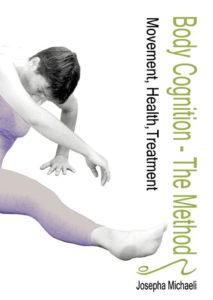about the book:

Since the development of “Body Cognition” in the 1960s and 1970s, thousands of people have experienced it. However, when we ask: What is “Body Cognition”, some of the answers are given in the negative form: this is not gymnastics in the usual sense; this is not a treatment for back pains only, and so on. How, then, can we define the “Body Cognition” method: education for a proper body movement? Training and preparing the body? Healthy gymnastics? These are titles which indicate several aspects of the method. The fundamental assumption of “Body Cognition” is that the right movement is beneficial to our physical and mental well-being and learning the right movement can considerably facilitate the solution of a long series of prevalent bodily problems.
The present book constitutes an ID of the method: an attempt to explain extensively, present reasons arguments and demonstrate its theoretical aspect as well as display its practical implementation. The description of bodily occurrences ranges from the unique and individual to the general, from the personal to the comprehension of the common as well as vice versa – from generalizations to the individual case. Each chapter illustrates the approach from a different perspective but all of them emphasize the method’s principal and unique trait: observing solid and general anatomical facts and, based on them, understanding their practical implications for the physical conduct from a health starting point. Moreover, the book shows the way the method relates to issues not usually associated with movement: physical therapy, personal development, learning, thinking and behavior.
The order of the chapters invites a linear reading, evolving according to their structural logic, and enabling the reader to benefit from the support given by each chapter to those that follow it. However, each chapter can stand by itself and refers to the others as the need may arise. Thus, the book can be read in any order, browsing freely between the chapters.
The book is designed for two main reader groups. The first group comprises all those interested in their body and health and want to delve deeper into the body out of personal and intellectual inquisitiveness. The second consists of professionals dealing with all the body therapy disciplines. The chapter topics and level of thoroughness are adjusted to both groups. Hence, all readers can find in the book what they are looking for in accordance with their level of interest and depth.
Table of content:
Page | |
INTRODUCTION | 1 |
Part 1: Bodily conduct along the lines of “Body Cognition” | |
1.1 What Is Bodily Conduct? | 7 |
1.2 The Ideal and Actual Situation | 14 |
1.2 The Learning of Bodily Conduct | 32 |
Part 2: MOTION AND POSTURE DEVELOPMENT | |
2.1 Posture and Awareness Thereof | 59 |
2.2 The Quality of Our Movements | 96 |
2.3 Movement – Position | 114 |
2.4 Strength and Agility | 126 |
2.5 Relaxation and Release | 149 |
2.6 The Proprioceptive System | 154 |
2.7 The Respiration | 162 |
2.8 Body, Thought, Cognition and Emotion | 174 |
Part 3: LESSONS AND TREATMENTS | |
3.1 Circular Complexity | 189 |
3.2 Movement Lessons | 193 |
3.3 Rest and Control Positions | 214 |
3.4 Slow is Faster 3.5 Verbal Communication | 228 239 |
3.6 One-on-One | 259 |
3.7 Do’s and Don’ts in “Body Cognition” | 317 |
Part 4: IN-DEPTH LOOK AT THE HUMAN BODY | |
4.1 Lordoses as Trigger Areas | 327 |
4.2 Centrality of the Abdominal Muscles | 367 |
4.3 The Pelvic Floor – The Lower Barrier | 413 |
4.4 The Thorax as a Junction | 422 |
EPILOG | 449 |
Lexicon of Terms | 454 |
Other Body Cognition books by Josepha Michaeli |
Price: 112 NIS
